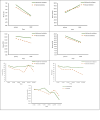Manual vs. Mechanical Ventilation in Respiratory Parameters of intubated Patients During cardiopulmonary Resuscitation; a Randomized Clinical Trial
- PMID: 40487904
- PMCID: PMC12145128
- DOI: 10.22037/aaemj.v13i1.2652
Manual vs. Mechanical Ventilation in Respiratory Parameters of intubated Patients During cardiopulmonary Resuscitation; a Randomized Clinical Trial
Abstract
Introduction: Ventilation and oxygen delivery during cardiopulmonary resuscitation (CPR) is of paramount importance. This study aimed to compare the effects of manual and mechanical ventilation on respiratory parameters of intubated patients during CPR.
Methods: This randomized controlled clinical trial was conducted in 2024 on 61 intubated patients with neurological disorders admitted to the ICU of educational hospitals. Participants were allocated to either the intervention or the control group using block randomization with a block size of six. The intervention group received mechanical ventilation, while the control group received manual ventilation using bag valve mask (BVM). The effects of manual versus mechanical ventilation during CPR on key physiological and respiratory parameters, including venous blood gases (VBG), end tidal Co2 (ETCO₂), and peripheral oxygen saturation (SpO₂) were compared between groups. Statistical analyses were performed using SPSS version 21.
Results: The study findings indicated no statistically significant differences between the manual and mechanical ventilation groups in terms of venous blood pH levels (P = 0.38), PCO2 (P = 0.65), and HCO3 levels (P = 0.47) changes. However, PO₂ (P < 0.001), ETCO₂ (P < 0.05). and SpO₂ (P < 0.001) were more stable and consistently higher in patients receiving mechanical ventilation.
Conclusion: These findings suggest that while pH, PCO₂, and HCO3 levels did not significantly differ between the two ventilation methods, mechanical ventilation demonstrated superior efficacy in optimizing oxygenation (PO₂ and SpO₂) and regulating ETCO₂ levels.
Keywords: Blood Gas Analysis; Carbon Dioxide; Cardiopulmonary resuscitation; Oxygen Saturation; Ventilation.
Conflict of interest statement
The authors have no conflicts of interest to declare
Figures


Similar articles
-
The effects of mechanical versus bag-valve ventilation on gas exchange during cardiopulmonary resuscitation in emergency department patients: A randomized controlled trial (CPR-VENT).Resuscitation. 2023 Dec;193:109966. doi: 10.1016/j.resuscitation.2023.109966. Epub 2023 Sep 12. Resuscitation. 2023. PMID: 37709163 Clinical Trial.
-
Automatic Mechanical Ventilation vs Manual Bag Ventilation During CPR: A Pilot Randomized Controlled Trial.Chest. 2024 Aug;166(2):311-320. doi: 10.1016/j.chest.2024.02.020. Epub 2024 Feb 18. Chest. 2024. PMID: 38373673 Clinical Trial.
-
Mechanical active compression-decompression versus standard mechanical cardiopulmonary resuscitation: A randomised haemodynamic out-of-hospital cardiac arrest study.Resuscitation. 2022 Jan;170:1-10. doi: 10.1016/j.resuscitation.2021.10.026. Epub 2021 Oct 25. Resuscitation. 2022. PMID: 34710550 Clinical Trial.
-
Effects of inspired gas content during respiratory arrest and cardiopulmonary resuscitation.Crit Care Med. 2000 Nov;28(11 Suppl):N196-8. doi: 10.1097/00003246-200011001-00006. Crit Care Med. 2000. PMID: 11098945 Review.
-
Pathophysiology and Prevention of Manual-Ventilation-Induced Lung Injury (MVILI).Pathophysiology. 2024 Oct 12;31(4):583-595. doi: 10.3390/pathophysiology31040042. Pathophysiology. 2024. PMID: 39449524 Free PMC article. Review.
References
-
- Gu W, Li C-S. Ventilation strategies during out-of-hospital cardiac arrest: a problem that should not be neglected. J Emerg Crit Care Med. 2017;1(9):Art. 9.
-
- Kill C, Dersch W, Wulf H. Advanced life support and mechanical ventilation. Curr Opin Crit Care. 2012;18(3):251–5. - PubMed
LinkOut - more resources
Full Text Sources
